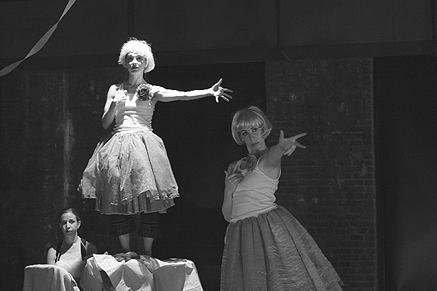Monica Bill Barnes crafts another nostalgic jewel
Monica Bill Barnes is kind of old-fashioned. From the looks of the three or four Barnes works I’ve seen—including “Thank You and Good Night,” recently premiered at Dance New Amsterdam—she’s happy to be that way. She would rather blow confetti in your hair or give your smile muscles and tear ducts a workout than be queen of the downtown scene.
Barnes scrunches bits of ballet, modern dance, show dancing, social dancing, and character-acting together under pressure, and spools out the results at a fast clip—a demanding mix. Although her dancers may not look like the coolest kids on the block, they’re strong, resourceful theater folk with that special something, like old-time show people determined to win audiences over by the sweat of their brows, or die trying. They come out swinging and stay in it for the duration.
With its party tables, balloons, and plastic champagne flutes filled with confetti, “Thank You and Good Night” appears to be set in an actual place, perhaps an anniversary fete. Dancers Beth Bradford, Deborah Lohse, Anna Smith, and Barnes resemble real people, entertainers in tacky Goodwill grandeur cavorting to a bouquet of Edith Piaf songs. Dashing, pelting, flapping, and whirling, they make a virtue an aesthetic—of bumptious, occasionally clumsy hyperactivity—putting far more effort into their moves than is warranted. They wear their hearts and their hungers on their sleeves. They grind us down then move in for the kill with an understated gesture here or there, something that briefly glints in the light as it slips past our defenses.
An elderly couple dressed to the nines—actor Jack Frankel and psychotherapist Ursula Caspary Frankel—sit at a table and look on, occasionally exchanging a whisper. Now and again, hubby Jack rises to propose simple, poignant toasts. He raises his glass once to the good times; next, to the bad times as his spouse winces and tries to wave his words away; and finally, to whatever lies in wait.
It’s possible to read the Barnes-Lohse and Smith-Bradford duets as projections of this couple’s inner worlds—their secret thoughts, flashes of competition for the spotlight, moments of dependency, tentative, reticent feelings of concern—all infused with breath and clad in fanciful costumes. When dancers slowly revolve atop party tables like sad little music box dolls or aimlessly shuffle in wave after wave of fallen confetti, one cannot help but think of decline and mortality.
The most irresistible duets involve Barnes—a tiny Power Puff Girl of a dancer with piquant features—and Lohse, whose height is as impressive as the overheated reactions registering in her eyes. Bedford and Smith are equally surefooted in technique and timing. Barnes has a sixth sense for talent and has been perceptive in her choice of dancers. Her trusted team includes costume and set designer Kelly Hanson, sound designer Karinne Keithley, and Jane Cox, whose painterly way with light most often recalls Toulouse-Lautrec.
gaycitynews.com


































